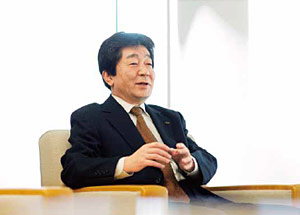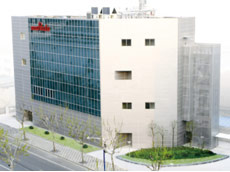Toru Inoue Executive Vice President and Director, Components Business Unit
After joining Murata Manufacturing in 1980, Inoue was assigned to the Accounting & Controller Dept. where, in addition to his accounting tasks, he developed collaboration with the industrial engineering department. Starting in 1990, he worked at plants in the UK and the USA and at the head office of Murata Electronics North America, Inc. before returning to Japan in 1998. He was then transferred from the Accounting & Controller Dept. to the Production Dept. at the Yokaichi Plant and from Ogaki Murata to the Corporate Planning Dept. and was appointed Vice President in 2009. Inoue became Director of the Components Business Unit in July 2013.
With every device increasingly digitalized, EMI (Electromagnetic Interference) is a great concern in the electronics industry.
The business of the Murata EMI Filter Division has two main pillars: noise suppression components and inductors. The latter is used to stabilize signals and power supplies.
These products are expected to generate increasing demand in keeping with the progress in communication technologies such as PCs and smartphones.
In the high growth potential markets of home electronics and automotive electronics, the above-mentioned Murata products are enjoying rapid growth in demand due to the increasing introduction of multifunctional devices enabled by communication technologies.
Here, offering components suitable for large current circuits and improving component reliability are the major challenges facing Murata.
We need to meet customer needs while taking advantage of our traditional expertise in communication and consumer product applications.
We have partnered with a successful supplier of a metal-based magnetic material that is needed to produce components for power lines. The Murata EMI Filter Division is now ready to address new markets and is paving the way toward next phase of growth.
The advent of PCs and mobile phones led to a sharp increase in demand. There have been steadily growing needs for noise suppression components and inductors. Size reduction, a specialty of ours, is one of the most important requirements.
Compactness, Large Currents, and High Q Demand for EMI Filter Division Products Grows with Digitalization
EMI suppression technology has recently been a focus of attention in keeping with the increasing digitalization of all equipment. Murata has been strong in providing inductors and noise suppression components that are relatively compact and used for relatively low-power lines. Looking back on our history, we supplied noise suppression components for radios and TVs as well as inductors for smoothing power supply voltage. Then the advent of PCs and mobile phones led to a sharp increase in demand. In the mobile phone market, customers primarily demand radio frequency inductors. But we also see needs for inductors for power lines. PC manufacturers have increasing needs not only for components that handle general signals. Growing wireless communications between PCs and external devices now also give rise to demand for products for radio frequency circuits. In these fields where products are increasingly commoditized, there have been steadily growing needs for noise suppression components and inductors. Size reduction, a specialty of ours, is one of the most important requirements.
One of Murata’s advantages is that we have three types of components produced using different processes: winding, thin film, and monolithic. This diversity allows us to make flexible proposals for customers depending on their needs. For example, customers who emphasize cost benefit can choose monolithic products, while performance-oriented manufacturers can be accommodated with winding technology.
With Reliable Components and Products for Large Current Circuits, Murata Is Reentering the Market for Power Products
The future of the Murata EMI Filter Division depends on how successfully we will be able to develop the market segments for home electronics and automotive electronics. The key words here are “large current and high reliability.” In the present market, non-power components represent 60% of overall demand and components for large-current power lines 40%. In four to five years’ time, however, we expect the latter’s share will increase to around 50%.
The fact is that we worked on components for large-current power lines in the past. But in the late 1980s, we were faced with increasing competition, and since then we have concentrated our resources on other fields. In the meantime, Murata has taken advantage of its outstanding downsizing technology to increase its market share with an emphasis on commodity products. So the company is now making a new attempt to enter the market for components for large-current power lines.
Product Size
Component downsizing is one of Murata’s traditional strengths. Murata noise suppression components and inductors are produced using three kinds of processes — winding, film, and monolithic — each having distinctive features. The winding process, which produces wire wound products, achieves the highest Q (quality factor) levels, but it offers only a limited scope for downsizing. Current wire wound products have become much smaller, yet they are still a few sizes larger than components produced using the film and monolithic technology. But again, their size has been reduced to 0302 (0.8 x 0.6mm). Our equipment for producing wire wound type coils also has an advantage: It is developed through a joint research program that combines Murata’s production technology with expertise of a machinery manufacturer.
On the other hand, the size of film and monolithic type products has been reduced to 01005 (0.4 x 0.2mm). Film type products have relatively high Q values, but fall short of the wire wound type. If the film process is further developed in the future to achieve Q values comparable with those delivered by the winding process, there could be a major shift in inductor size.
The challenge is to build close relationships with customers that allow us to be involved in their product development activities right from the initial phase.
Strengthening Capital Alliance with Toko, Producer of a Promising Metal Magnetic Material
In February 2013, Murata formed a capital alliance with Toko, Inc., an electronic component manufacturer, and started joint development. Murata’s new partner is strong in supplying highly reliable inductors and coil transformers for large current lines. The greatest highlight of these products from Toko is the use of “Metal Alloy” a metal powder-based magnetic material, which makes it possible to deliver lower DC resistance with high inductance to maintain high performance in large current circuits. We aim to take advantage of this technology and relevant processes to increase our sales in the market for products for large-current power lines.
Murata has traditionally reduced costs by automating its production processes. The aim is to make its products cost competitive even when they are produced in Japan, a market with high labor costs. By contrast, Toko got an early start in overseas production for cost reduction. It now produces all its products outside Japan. Despite the difference in the nature of our production networks, we hope both companies will be able to combine their expertise to create something new. With a focus on the newly established joint development team, Murata expects to build an even closer relationship with Toko. To this end, both partners will enhance their capital alliance even further.

Metal-Based Material Provides Us a Business Opportunity
Suppose we had no metal-based materials available. Even then we could use ferrite-based materials to achieve certain levels of characteristics. But the advantage of metal-based materials is that they make it possible to create components that are smaller and can accommodate large currents. If we did not partner with Toko and started to develop metal-based materials from scratch, it would take at least three years to develop similar materials. And we would have no revenue in the meantime. Assuming that it will take a few more years for new metal-based products to spread in the market after their launch, we would lag a way behind the competition. In other words, the partnership with Toko has given us the opportunity five years earlier.
Components made of metal-based magnetic materials have been finding use in the power supply circuits of feature phones and smartphones for one and a half years now. These components deliver higher performance than ferrite counterparts. This is why they spread rapidly — especially in smartphones — as soon as their market launch. By combining Toko’s metal technology with Murata’s sales network, we expect to increase sales of these components significantly. We can also anticipate synergy in production. This leadership of ours will likely continue for a few more years, but in the meantime we also need to prepare new products by anticipating the market needs that will arise from that point on.
Our challenges include internal collaboration and information sharing with other departments, and proposing solutions to customers.
Challenges: Closer Relationships with Customers, and Collaboration and Information Sharing with Other Departments
Our challenge from this point on is to build close relationships with customers that allow us to propose solutions for them right from the initial phase of their product development activities. Murata supplies a variety of electronic components and has a diverse customer base. All our product departments have access to various information. So if they can share it with each other, we will have a new strength. In particular, product departments supplying modules are positioned closer to product development at customers than departments producing traditional components.
We are looking to develop ways of obtaining such information about business levels closer to final products not only from our customers, but also from within.
Proposal of Solutions: a New Approach to Sales Promotion by Sales Engineers
The EMI Filter Division has many opportunities to propose solutions for its customers, since it has traditionally supplied many components that need matching with the circuits they will be integrated into. Making proposals and getting information out of customers is the responsibility of sales engineers. If we are to be successful in new markets like energy, healthcare, and in-vehicle equipment, we must find out customer needs more actively than ever. As part of these efforts, we will further upgrade our electromagnetic anechoic chambers, located in Japan and abroad, to help identify customer needs more accurately.
Electromagnetic Anechoic Chamber
Test equipment isolated to prevent electromagnetic interference with and from external equipment, the anechoic chamber has an internal structure that prevents the reflections of electromagnetic waves. Murata has anechoic chambers in Nagaokakyo (Head Office), Yokohama, and Shanghai. Registered at FCC (U.S. Federal Communications Commission) and VCCI, the Murata anechoic chamber facilities have not only an anechoic chamber that can be used for antenna evaluation, but also various test equipment. The anechoic chamber building in Shanghai was opened in 2010. With the progress in wireless technology in Greater China, various noise problems have surfaced in the course of design and development at many electronic manufacturers. To resolve these problems, Murata built the electromagnetic anechoic chamber facility in Shanghai, which is equipped with modern measurement instruments. This facility also serves as an application service site for customers.

Electromagnetic Anechoic Chamber Building (Murata EMC Center) at Murata (China) Investment Co., Ltd.
“Metal Alloy” Inductors
Toko is the pioneer in developing a magnetic material made of metallic powder. Unlike traditional nickel/zinc or manganese/zinc magnetic materials for ferrite-core inductors, the Toko “Metal Alloy” magnetic material is based on carbonyl iron or atomized iron. Other metal materials are added to this basic material and mixed with a thermoset resin (binder) for insulation. An air-core coil is embedded in this insulated material to form an integrated component. “Metal Alloy” inductors are useful for energy savings since they have outstanding DC superposition characteristics and lower DC resistance and allow for a longer battery life compared with conventional coils.